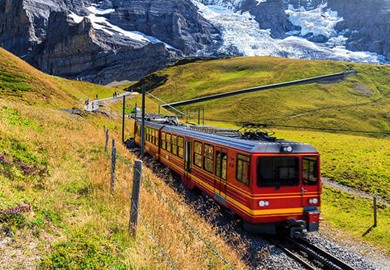5 results matching: Jungfrau Express

 (256 reviews)
(256 reviews)
- DestinationGermany, Switzerland
- Starts / EndsSt Pancras International
- AccommodationCruise
- TransportRail, Cruise
The route from Interlaken to Jungfraujoch, Europe's highest railway station, actually comprises three different railways.
The first leg from Interlaken to Lauterbrunnen is on the Bernese Oberland Railway. This narrow-gauge line was opened in 1890 and is 12 miles in length. Over the course of the route, the line climbs 467 metres above sea level. The line was electrified in 1914 and some of these electric locomotives survive for use on special trains today. However, nowadays services are mostly run by specially-designed trains with low floors, built to maximise the views of the beautiful alpine scenery.
At Lauterbrunnen, the Wengernalp Railway runs to Kleine Scheidegg. This is also a narrow-gauge line and was opened to the public in 1893. Due to the steep incline of the route, the line is actually the world's longest rack railway at 12 miles. The views are outstanding, with highlights including the White Lütschine River valley and the Staubbach Falls.
The Jungfrau Railway begins at Kleine Scheidegg and runs the remaining six miles to just below the summit of the Jungfrau Mountain. The narrow-gauge line was opened in 1912 after a long building process. Although much of the line is in a tunnel, the route includes an observation deck with windows built into the passage, to maximise the fantastic views. On emerging from the tunnel, the train arrives at Jungfraujoch, which at 11,333 feet is the highest railway station in Europe.
Due to the steep area through which it runs, the line is actually the world's longest continuous rack railway at just over 12 miles. On this particular stretch of the route, the views are absolutely outstanding, with highlights including the White Lütschine River Valley and the Staubbach Falls.
The final section of the journey is on the Jungfrau Railway, which begins at Kleine Scheidegg and runs the remaining six miles to just below the summit of the Jungfrau Mountain. The narrow-gauge line was opened in 1912, following a long and difficult building process.
Although much of the line is in a tunnel, the route includes an observation deck with huge windows built into the passage, to maximise the fantastic views. On emerging from the tunnel the train arrives at Jungfraujoch, which at 11,333 feet (3455 metres) is the highest railway station in Europe.

 (256 reviews)
(256 reviews)

